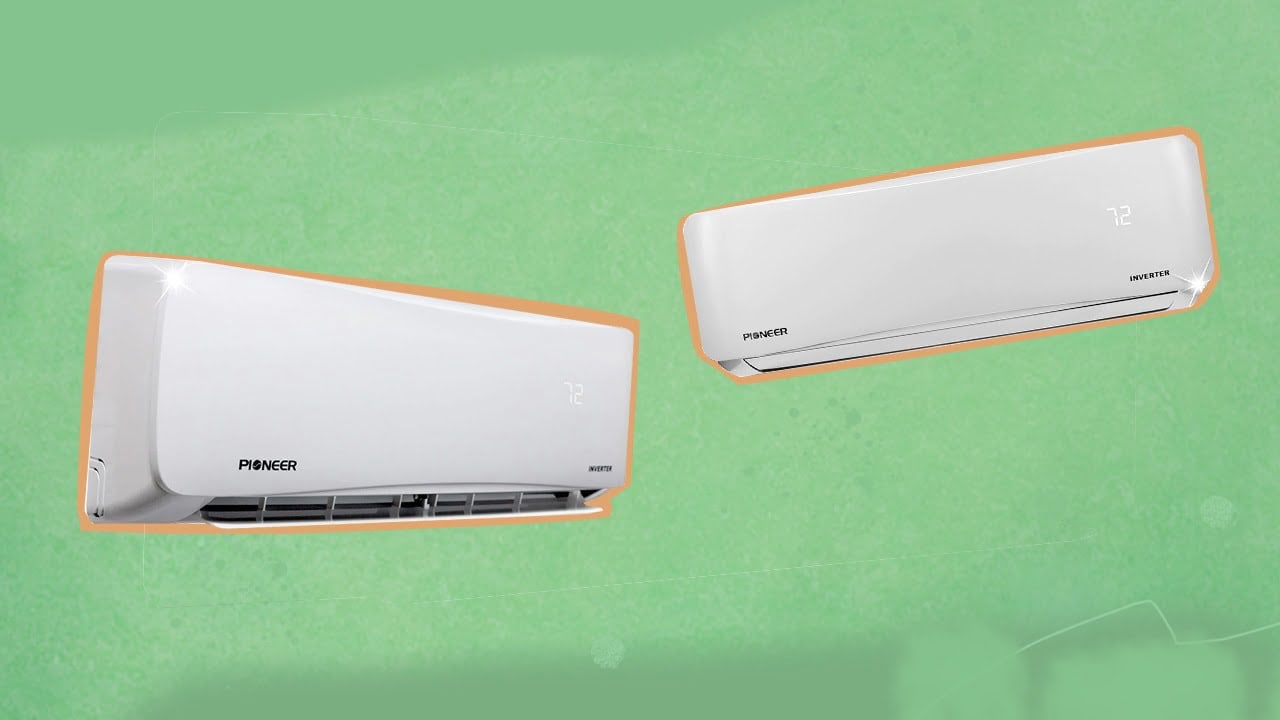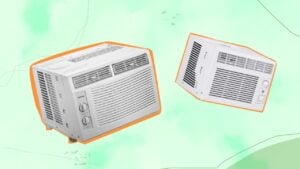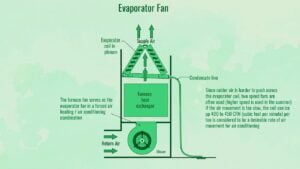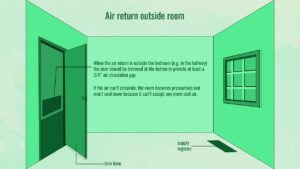How Many CFM Per Ton Of Cooling Do You Need – A Complete Guide
In most cases, an AC unit should have 350 to 400 CFM per ton of cooling for the most effective results. But sometimes, the number of CFMs required may be more or less depending on certain factors like humidity and HVAC unit size. If you’re planning to get a new air conditioner installed, the CFM […]

In most cases, an AC unit should have 350 to 400 CFM per ton of cooling for the most effective results. But sometimes, the number of CFMs required may be more or less depending on certain factors like humidity and HVAC unit size.
If you’re planning to get a new air conditioner installed, the CFM rating is one of the most important things to consider.
People generally assume an AC unit with a higher CFM rating offers better cooling. But this is not always the case, which is why learning about how many CFM per ton of cooling you require is quite essential.
And that’s just what this detailed guide can help you do. So, let’s start!
What Does CFM Refer To In Air Conditioning?

CFM, or cubic feet per minute, is a measurement unit that determines the amount of air that an air conditioning unit can move in a minute. A higher CFM means that your air conditioner can move a larger amount of air in that time. Generally, you require 350-400 CFM for every 12,000 British Thermal Units or BTUs for optimal cooling.
BTU is the measurement unit used to measure the cooling power of an air conditioning system, and 12,000 BTUs are equal to one ton. It is a common misconception that a higher CFM offers better cooling. In reality, there are other factors, such as BTUs, that determine how effective your air conditioner is.
The cooling capacity of air conditioning systems installed in homes generally ranges from 18,000 BTUs to 60,000 BTUs, or 1.5 to 5 tons. Other factors that can affect cooling include the climate, home size, installed insulation, and humidity level.
CFM also applies to heating capacity in the same manner. 350 to 400 CFM per 12,000 BTUs provides adequate airflow to help circulate the heated air through the supply ducts. It also pulls cool air back to the air handler or furnace.
A 3-ton HVAC system should have around 1050 to 1200 CFM, while a 3.5-ton one should be able to move 1600 CFM at the very least. But as I mentioned before, this can vary depending on various factors. For instance, if you reside in an area with a hot and humid climate, an HVAC system capable of moving 450 CFM per ton might be a better option.
In contrast, households that are insulated properly may only need an AC unit with a capacity of 350 CFM per ton. I recommend consulting an HVAC technician who can provide accurate information regarding the exact amount of CFMs required for your home.
Calculating CFM
The CFM of a blower depends upon the size of its centrifugal fan and the horsepower capacity of its motor. Every blower fan assembly is given a rating when it is manufactured. And this rating determines how many cubic feet of air it can move in a minute, depending on its speed.
The CFM per square foot depends on the following factors:
- HVAC system size
- Blower CFM rating
- Size of the area where the system is installed
You can use this formula to determine the correct CFM required for a particular room – Tonnage x CFM of the blower / Number of square feet. For instance, a 2000 square foot room that has a 4-ton AC unit with a blower with a 400 CFM rating will have a CFM of:
4-ton AC x 400 CFM blower / 2,000 square feet = 0.8 CFM per square foot. However, including the number of air changes per hour or ACH would require additional calculation. Let’s take another example for this purpose.
A room with an area of 1600 cubic feet and a height of eight feet would need the air to be changed every ten minutes at 160 CFM. This means that the air will need to be changed six times every hour.
For more frequent air changes, a larger amount of air will need to be supplied to the room, and there should also be another return air vent. Calculating the CFM can also be done through various websites that provide tools like online calculators where you just need to enter the data regarding the room and HVAC size.
CFM And HVAC Size
A larger heating, ventilation, and air conditioning system can deliver more CFMs, but this also depends on the size of the blower. Knowing how many CFMs your system can deliver can make it easy to know the CFM requirement of the room it is installed in. It can also help you know how much time it takes to change the air.
For instance, a 1-ton AC unit has a CFM rating of 350 to 400, while that of a 1.5-ton one will range from 525 to 600. Similarly, a 2-ton AC unit will have a CFM rating ranging from 700 to 800, and a 2.5-ton one will have a rating between 875 and 1000. A 3-ton AC unit can deliver 1050 to 1200 CFMs, and a 3.5-ton one can deliver 1225 to 1400 CFMs.
Finally, a 4-ton unit has a CFM range of 1400 to 1600 CFMs, while for a 5-ton unit, the CFM can range from 1750 to 2000. Now, let’s look at the furnace capacity, which can also be very useful for airflow calculation.
A 60,000 BTU furnace generally has a CFM rating ranging from 1750 to 2000, while an 80,000 BTU one will have it between 2320 and 2250. For a 160,000 BTU furnace, this rating lies between 4670 and 5350.
Standard CFM Rates
As I’ve explained above, when it comes to cooling capacity, 400 CFM per ton is the industry standard. Other flow rates depend on the cooling system you use to lower the room air temperature.

For High Latent Heat Systems
Latent heat cooling systems use a cooling medium that can change its state depending on the temperature. Such a medium is usually a refrigerant that can change from liquid to gas during the cooling process. For such systems, 350 CFM per ton of cooling capacity is ideal.
Sensible Heat Systems And Heat Pumps
Often heat pumps do not send air through the evaporator or cooling coil but around them. This air is called bypass air, and these systems require 500 CFM per ton of cooling capacity for the best performance.
Why Do More Humid Climates Require AC Units With Less CFM?
Many people wonder why humid climates require air conditioning systems with less CFM, assuming that more CFMs will be required to cool the environment. However, the reason you need fewer CFMs is related to how an air conditioner operates to remove hot air from its surroundings.
When an air conditioner cools down a room, it also removes moisture from the area. Cooler air cannot hold as much moisture as warmer air and, therefore, has a lesser amount of latent heat. The process by which HVAC systems remove moisture from the air is called dehumidification, which is also important for removing heat.
As a rule of thumb, such systems will work much harder in humid climates to get rid of the heat and moisture. But they do not need to move a large amount of air for effective cooling.
Why Do Drier Climates Require More CFMs?
You may think that AC units installed in drier climates will require fewer CFMs since dry air is easier to cool. But in reality, the higher latent heat in dry air makes it harder to cool than air in humid climates. Because of this, an HVAC system is unable to remove as much moisture from the air.
With more moisture, the air still has some heat left remaining, which is why your AC will need more CFMs to cool the house properly.
Situations Where A Higher CFM Is Needed
Here are a few situations where you may require more CFMs than is needed on average.
1. A Large Sized Home
A larger home will require an air conditioner with a bigger cooling capacity and more CFMs. This is because the air conditioner will have to move a larger amount of air so that all the rooms in the house are cooled properly.
On the other hand, those with smaller houses may not need as many CFMs for effective cooling.
2. Having Improper Insulation
In the case of houses that are not insulated properly, the cooling system has to work harder to maintain a lower temperature. The building insulation may be poor due to the use of inferior quality insulating materials used in its construction. Similarly, the attic may not be insulated properly, or there may be gaps in windows and doors, allowing air to pass through.
If your home does not have proper insulation, more CFMs will be required to keep it cool.
3. Residing In A Hot Climate
Households located in areas where the climate is hot will require more CFMs to get rid of moisture. But if the humidity is high and the air contains a lot of moisture, the number of CFMs required may not be as much, as I explained above.
When humidity levels are around 50%, 500 to 600 CFMs per ton will be required.
What Happens If You Do Not Have An Adequate Number Of CFMs?
Having an adequate number of CFMs is crucial to ensure that your AC can function optimally. In the absence of an appropriate number of CFMs, certain issues may arise, which can include:
- Improper cooling
- Stuffy and hot rooms
- Higher power bills
- Short-cycling of the AC unit
- More frequent breakdowns
- Shorter lifespan of the unit
How Is CFM Related To Room Size?
When it comes to the question of how many CFMs are required for a room, there is no standard answer. The ideal number of CFMs will depend on how frequently the air needs to be changed. You can use the room size per square foot to calculate the number of CFMs needed for two air changes per hour or 2 ACH.
A room with an area of 200 square feet will require 53 CFMs at 2 ACH, while one with 500 square feet will need 133 CFMs. Larger rooms, such as those with 2000 or 3000 square feet, will need 533 and 800 CFMs, respectively.
Air Circulation And Cooling Efficiency
Proper air circulation is also an important factor that should be considered when determining the cooling efficiency of your HVAC system. The reason is that if air cannot circulate properly, such as in a locked room that does not provide any space for air to escape, air pressure builds up inside.
This means that it cannot accept any more air coming from the air conditioner, and there will be no temperature drop, leading to ineffective cooling. To prevent this from happening, you can install a door that is slightly trimmed at the bottom, providing a gap for air to pass through. Ideally, this gap should be ¾ inches for best results.

What Is Better, High CFM Or Low CFM?
To ensure better indoor air quality and more effective cooling, having the right number of CFMs is vital. But the number of CFMs required for different-sized homes can vary, with some needing a higher CFM while others may require a lower one.
Issues With A Higher CFM
Sometimes, having an extremely high CFM can lead to certain problems. One of them is that such a CFM will result in a breeze blowing through your home, which may not be comfortable at all times. This is especially true in winter when you need better heating instead of cooling.
Similarly, higher CFM can worsen the humidity in very humid climates. Apart from removing heat from the air, your AC unit removes humidity from the air by passing the air over its evaporator coil. This coil is very cold, because of which condensation occurs and turns the moisture in the air to water, which passes through the wastewater pipe and goes into the drain.
However, when the CFM is too high, air passes over the evaporator coil very quickly without allowing the moisture to condense. Thus, the overall humidity in your home will increase, leading to problems like mildew and mold growth.
Problems With A Lower CFM
HVAC systems generate a huge amount of heat while operating. If the CFM is too low, proper air circulation cannot take place, and this heat has nowhere to go. When this happens, rooms located near the system can become extremely hot, while those further away will get uncomfortably cold in winter.
However, during summer, the reverse will take place, with the living space closer to the furnace becoming colder and areas further away becoming hotter. That is why having the right number of CFMs is ideal, which is generally 350 to 400 CFM per ton.
How Is Indoor Air Quality Related To ACH?
Indoor air quality is affected by several factors, such as the number of occupants in a room, how the room is used, and others. In some rooms, such as the kitchen, the air contains a lot of moisture and different odors. Similarly, a room used as a home workshop may have a lot of dust.
Rooms with more occupants, such as the dining room, will also have inferior indoor air quality. In all these situations, you will need to change the air more frequently, and that is why the CFM should also be higher.
Ductwork, CFM, and ACH
To ensure that your rooms get enough CFMs, the size of the ducts making up the HVAC duct system should be large enough. As is obvious, a smaller-sized duct will allow a smaller amount of CFMs to pass through. However, the size is not the only consideration, as the shape also affects how many CFMs are delivered through the HVAC ductwork.
One of the most challenging tasks for HVAC technicians is determining the most suitable duct size for a specific room. To make the task easier, they generally rely on computer programs that consider factors like the room size, CFM rating of the blower, size of the HVAC system, etc.
An important factor that can affect how well the HVAC ducts work is static pressure, which refers to the amount of pressure present while the blower fan is in operation. When this pressure is higher, the system has to work harder to supply air and ensure proper air circulation.
Tip
When selecting the ductwork size, you need to consider the amount of CFM that has to move through it. 4-inch ducts deliver 20 CFMs, 6-inch ones deliver 75 CFMs, and 8-inch ones deliver 160 CFMs. Keep in mind that the total duct runs should not be more than the CFM output of your AC unit.
Application Of CFMs To Different Types Of HVAC Equipment
All types of HVAC fans come with a rating for CFMs, which lets you know about the ideal CFM for the machine. Both the required ACH and recommended CFM ratings should be considered when looking for components like air purifiers, heat pumps, ductless air conditioners, and others.
Such ratings are also present for whole-house fans, ceiling fans, dehumidifiers, garage heaters, portable ACs, and attic fans.
The Relation Between Air Velocity, CFM, And HVAC Equipment
Air velocity is closely related to CFM and should be considered when determining how many CFM per ton is required for lowering the air temperature in a room. It is defined as the quantity of air that is moved per unit of time and is measured in liters/meters per minute (LPM) or feet per minute (FPM).
This varies significantly for different components of your HVAC system and can determine how effective it is in cooling a particular space. For standard air ducts, the recommended air velocity or air flow ranges from 700 to 900 FPM for residential structures. But it is considerably higher for commercial and industrial systems, generally ranging from 1000 to 1800 FPM.
For replaceable air filters, the recommended airflow is 700 to 750 FPM, while that for low-velocity disposable ones is 300 FPM. Similarly, the airflow for a washable high-velocity air filter is 650 FPM. A heat pump or condensing coil should have an FPM of 1000, while for the evaporator and cooling coils, it ranges from 400 to 600 FPM.
Finally, the maximum recommended airflow for a heating coil is 700 FPM.

Final Thoughts
With that, this guide has come to an end, and hopefully, now you know how many CFM per ton of cooling is required. In most situations, 400 CFMs per ton of cooling will be more than adequate, but there may be instances where you need a higher or lower amount of CFMs.
If you’re not sure about the number of CFMs required for proper cooling in your home, I recommend talking to an HVAC professional. Such professionals can perform an inspection of the house and recommend the most suitable system that can provide the required number of CFMs.
This will help make your home comfortably cool without worrying about the technical aspects.
